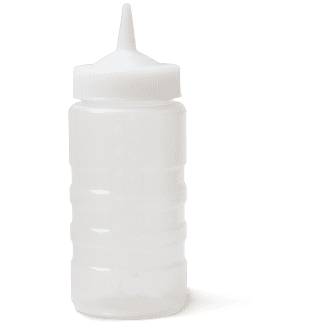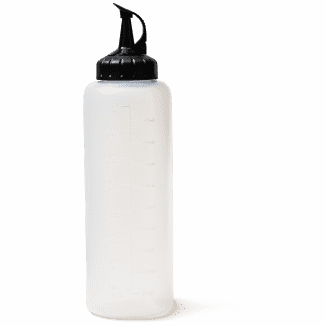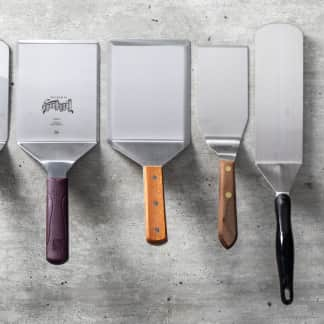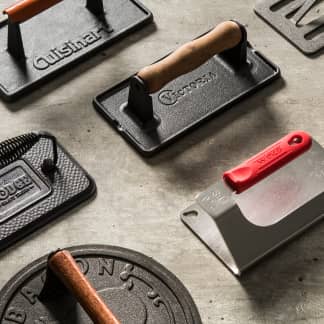Once seen mostly in restaurant kitchens and at hot dog stands, squeeze bottles have become increasingly common in home kitchens as well. They’re handy for storing and dispensing oil, vinegar, and other condiments and sauces. We like them in particular because they offer a precise, controlled pour. By squeezing the flexible plastic sides of the bottle, you can easily modulate the volume of food that comes out through the narrow spout—a welcome development for anyone who’s ever tried to measure an exact tablespoon of olive oil from the bottle and ended up with a whole counter doused in it. We wanted to know which squeeze bottle was best for home cooks, so we bought five widely available models priced from about $1.00 to about $6.00 per bottle. While these bottles come in many sizes, we decided to focus on bottles with a capacity of 16 ounces, the most common and practical size available, using each to store and pour different volumes of water, simple syrup, oil, and ketchup and to make, store, and pour Make-Ahead Sherry-Shallot Vinaigrette.
Wide Mouths Make For Easier Filling
All the bottles did a good job of holding and dispensing their contents; none of these bottles will ruin your day unless you neglect to screw the top on tightly before use. But a few features made certain models a little easier to use than others. When it came to filling them, we much preferred bottles with wider mouths (the bigger openings below the lid you use to fill the bottles) that measured about 2 inches in diameter. Bottles with narrower mouths required us to aim more carefully as we poured freehand into the bottle from a larger vessel; when we used a funnel, it sat slightly less securely in these narrower mouths, tipping to one side more readily than in the wider ones. Bottles with wide mouths were also easier to clean, providing plenty of clearance for us to insert our favorite bottle brush so that we could scrub out any sticky ketchup or pieces of shallot and herb from the vinaigrette.
Bottle Circumference Matters Slightly; Flexibility And Material Matter More
In general, bottles with narrow mouths had narrow bodies as well, with most measuring about 8 inches around. These narrower bottles were slightly easier for testers with smaller hands to grip securely, but even larger bottles with circumferences of about 9 inches were manageable for most hands.

The flexibility and type of plastic used to make the bottles were more important than their circumference. Stiffer bottles were harder to squeeze, requiring a little more muscle to dispense their contents. The stiffest model was made from high-density polyethylene (HDPE), which is typically more rigid than the low-density polyethylene (LDPE) used to make the other bottles. The HDPE model didn’t stand up to repeated use quite as well as the more flexible LDPE ones: Because it was so inelastic, it bent out of shape slightly when we squeezed it 100 times, although it was still usable. We preferred the bottles made from the thinner, more flexible LDPE, which took a bit less effort to squeeze and rebounded from repeated use more readily. Regardless of flexibility, all the bottles were capable of dispensing their contents neatly and precisely; each allowed us to slowly squeeze out oil while making vinaigrette and could be used to write legible words with ketchup (a critical test for those who like their birthday messages delivered on hot dogs instead of layer cakes).
Simple Bottle Tops Were Best
Finally, we looked at the bottle tops. We were intrigued by models that came with caps that covered the spouts. But while these caps were great for keeping out any dust, crumbs, and bugs that might have gotten into the bottles, they were frustrating in other ways. One model had a tiny cap that was easy to lose, disappearing into the dish drying rack for a few days before turning up again. Another model solved this problem by attaching the cap to the bottle top with a hinge, but this created a new problem: We had to orient the bottle in a specific position to keep the cap out of the way of what we were dispensing. Caps of both styles were also somewhat finicky to clean.
The bottle top on the model with the hinged cap was especially finicky to reattach and clean, as it had two separate parts—a collar that went around the neck of the bottle, and a small conical tip (with the hinged cap) that had to be fitted into the collar before screwing the whole thing into place. In general, most of us preferred simple, one-piece bottle tops with no caps or extra parts that required special cleaning or that could be lost; we’re willing to deal with the occasional crumb or bit of dust that might make its way into the bottle.

The Best Squeeze Bottle: The Tablecraft Widemouth Squeeze Bottle
Our favorite squeeze bottle is the Tablecraft Widemouth Squeeze Bottle, which sells for about $9.50 for six bottles, or about $1.50 per bottle. Its wide mouth makes it easy to fill and clean, and its very flexible plastic body is durable yet easy to squeeze; it comes with a simple, one-piece bottle top. If you really want a cap to protect the contents of the bottle and don’t mind the finicky cleaning it will require, Tablecraft offers sets of special “tethered” caps that fit onto the bottle spouts, about $8.00 for 12, providing plenty of extras in case you accidentally lose one. We found them easy to attach and thought they did a good job of sealing off the bottles securely.
- Wide mouth for easy filling and cleaning
- Flexible body made from low-density polyethylene (LDPE)
- No cap
- Test five 16-ounce plastic squeeze bottles, priced from about $1 to about $6 per bottle
- Store and dispense different volumes of water
- Store and dispense different volumes of simple syrup
- Store and dispense different volumes of ketchup
- Store and dispense different volumes of oil
- Use to make, store, and dispense Make-Ahead Sherry-Shallot Vinaigrette
- Squeeze each bottle 100 times
- Wash according to manufacturers’ instructions 10 times











